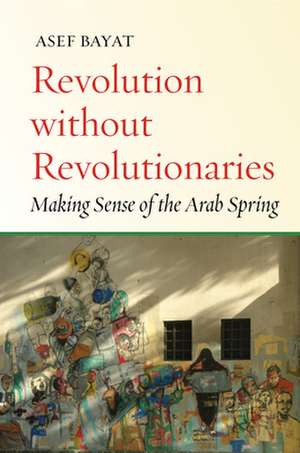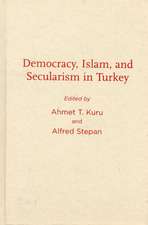Revolution without Revolutionaries – Making Sense of the Arab Spring: Stanford Studies in Middle Eastern and Islamic Societies and Cultures
Autor Asef Bayaten Limba Engleză Paperback – 31 iul 2017
Revolution without Revolutionaries is both a history of the Arab Spring and a history of revolution writ broadly. Setting the 2011 uprisings side by side with the revolutions of the 1970s, particularly the Iranian Revolution, Bayat reveals a profound global shift in the nature of protest: as acceptance of neoliberal policy has spread, radical revolutionary impulses have diminished. Protestors call for reform rather than fundamental transformation. By tracing the contours and illuminating the meaning of the 2011 uprisings, Bayat gives us the book needed to explain and understand our post-Arab Spring world.
| Toate formatele și edițiile | Preț | Express |
|---|---|---|
| Paperback (1) | 160.61 lei 22-36 zile | +19.07 lei 6-12 zile |
| MK – Stanford University Press – 31 iul 2017 | 160.61 lei 22-36 zile | +19.07 lei 6-12 zile |
| Hardback (1) | 622.09 lei 43-57 zile | |
| MK – Stanford University Press – 31 iul 2017 | 622.09 lei 43-57 zile |
Din seria Stanford Studies in Middle Eastern and Islamic Societies and Cultures
-
 Preț: 149.68 lei
Preț: 149.68 lei -
 Preț: 162.45 lei
Preț: 162.45 lei - 23%
 Preț: 681.00 lei
Preț: 681.00 lei -
 Preț: 174.37 lei
Preț: 174.37 lei -
 Preț: 202.66 lei
Preț: 202.66 lei -
 Preț: 172.58 lei
Preț: 172.58 lei -
 Preț: 194.70 lei
Preț: 194.70 lei -
 Preț: 203.47 lei
Preț: 203.47 lei -
 Preț: 218.33 lei
Preț: 218.33 lei -
 Preț: 171.47 lei
Preț: 171.47 lei -
 Preț: 146.38 lei
Preț: 146.38 lei -
 Preț: 200.42 lei
Preț: 200.42 lei -
 Preț: 203.00 lei
Preț: 203.00 lei -
 Preț: 201.19 lei
Preț: 201.19 lei -
 Preț: 169.59 lei
Preț: 169.59 lei -
 Preț: 174.96 lei
Preț: 174.96 lei -
 Preț: 201.29 lei
Preț: 201.29 lei -
 Preț: 202.44 lei
Preț: 202.44 lei -
 Preț: 202.19 lei
Preț: 202.19 lei -
 Preț: 194.65 lei
Preț: 194.65 lei -
 Preț: 160.61 lei
Preț: 160.61 lei -
 Preț: 201.08 lei
Preț: 201.08 lei -
 Preț: 202.72 lei
Preț: 202.72 lei - 19%
 Preț: 706.64 lei
Preț: 706.64 lei -
 Preț: 200.54 lei
Preț: 200.54 lei -
 Preț: 214.36 lei
Preț: 214.36 lei -
 Preț: 245.49 lei
Preț: 245.49 lei -
 Preț: 211.68 lei
Preț: 211.68 lei -
 Preț: 247.40 lei
Preț: 247.40 lei - 23%
 Preț: 723.50 lei
Preț: 723.50 lei
Preț: 160.61 lei
Nou
30.74€ • 33.40$ • 25.84£
Carte disponibilă
Livrare economică 31 martie-14 aprilie
Livrare express 15-21 martie pentru 29.06 lei
Specificații
ISBN-10: 1503602583
Pagini: 312
Dimensiuni: 152 x 229 x 17 mm
Greutate: 0.46 kg
Editura: MK – Stanford University Press
Seria Stanford Studies in Middle Eastern and Islamic Societies and Cultures
Cuprins
Chapter 1 sets the broad historical and conceptual framework for historically locating the revolutions of the new millennium, including the Arab Spring and the Occupy movements, by comparing them to the radical revolutions of the 1970s, notably those in Iran, Yemen, and Nicaragua. It suggests that the Arab uprisings and the Occupy movements came to fruition in a different historical time dominated by neoliberal norms that disparaged the very idea of revolution, collectivist ideals, and distributionist justice. The result was "refolution," or revolutions with a nonradical outcome.
Chapter 2 shows how the revolutions of the 1970s, unlike the Arab Spring, were informed by an intellectual component with socialist ideas as a major element. It focuses on the Iranian revolution of 1979 in which revolutionary ideas were articulated by Marxist and Islamic leftist guerrilla movements, as well as the "ideologue of the revolution," Ali Shariati. The revolution saw radical strategies and repertoires to which revolutionary ideas lent support.
Chapter 3 elaborates on the revolutions' radical repertoires and strategies by examining the widespread shura (council) movements for grassroots democracy and self-rule in the neighborhoods, colleges, farms, and workplaces, focusing on the occupation of factories. With the fragmentation of labor and the end of existing socialism, radical ideas began to lose their clout.
Chapter 4 examines the deradicalization of political Islam, showing how the Islamist opposition evolved from its strong anti-imperialist and social justice propensity to embrace reformist politics and neoliberal economy. By the time the Arab uprisings occurred, most Islamists and secular counterparts had been conditioned by the neoliberal climate. The chapter shows that ISIS somehow represents Islamism of neoliberal times.
Despite the decline in revolutionary projects, popular dissent grew as neoliberalism transformed the Arab economies and shaped an increasingly contentious urbanity.
Chapter 6 examines how dissent found expression in the Arab cities' public spaces, in particular the Arab squares, during the uprisings. It addresses the question of what the urban locus of the uprisings tells us about their origin and dynamics and why certain spaces, such as squares, become the site of popular contention. It focuses on Cairo's Tahrir Square, Tunis's Bourguiba Boulevard, and Istanbul's Taksim Square as sites of street politics, exploring the regimes' "counter-square" strategies.
Although it was not unexpected that the uprisings took place in urban areas, their sudden and fierce eruption surprised both observers and activists. Chapter 7 explores the way in which Arab subaltern groups were involved in discreet everyday struggles to enhance their life chances under the shadow of an authoritarian government and neoliberal economy. They had created their own opaque and illegible realities, "uncivil societies," under the radar of the state and scholars. Their struggles, often in the form of nonmovements, assumed a collective voice once the protests began and merged into what came to be known as the Arab uprisings. Surprise also lay in their ideological makeup and political trajectories.
Chapter 8 examines the particular "refolutionary" character of the Arab Spring in Tunisia, Yemen, and Egypt, discussing their promise as well as their serious limitations in transforming into full-fledged revolutions. The chapter argues that what transpired in the Arab world were not revolutions in the sense of their twentieth-century counterparts but a mix of revolutionary mobilizations and reformist trajectories. To illustrate this, the chapter discusses the impact of neoliberal normativity on the thinking of the political class, both Islamists and non-Islamists.
While there was little change in the structure of state power and the old elites, things were different at the societal level. Chapter 9 shows that the extraordinary acts of claim making by the poor, women, lower-class youth, and social minorities in pursuit of equality, inclusion, and recognition radicalized these otherwise nonradical revolutions.
Chapter 10 discusses the contradictions of the postrevolutionary "transition." It demonstrates that the subaltern struggles discussed earlier made, in part, the postrevolutionary transition acutely contentious, reinforcing the painful and paradoxical postrevolutionary moments. The revolutions remained largely defenseless against the domestic and regional counterrevolution, which in turn had a devastating impact on efforts to achieve a just and free social order in Arab societies, feeding into the rising disenchantment with the experience and idea of revolution.
Chapter 11 discusses the question of despair that came to afflict so many activists in postrevolutionary moments and concludes by exploring grounds for hope and the renewal of a revolutionary spirit in the post<->Arab Spring Middle East.
















